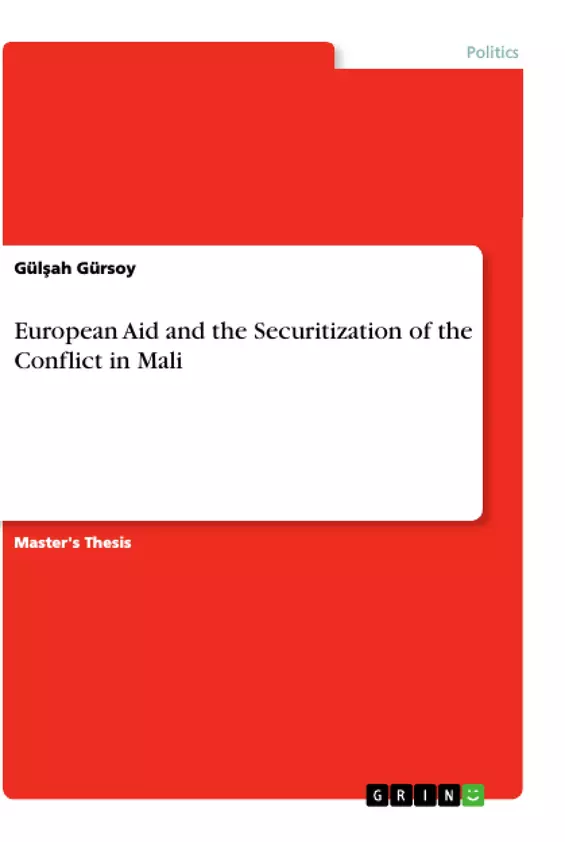Foreign aid and military interventions have been important determinants in Mali’s domestic politics for decades. Focusing on the European Union (EU) as an external actor in Mali, this study investigates the relationship between the EU’s political discourse and aid policy in this country. I looked at the amount of European humanitarian and military aid sent to Mali between 2010 and 2014. I also looked at the framings of Mali in the European Parliament’s (EP) debates within the same time frame. In this way, this study investigates whether there is a connection between the framings of Mali in the EP debates and the types and amount of European aid sent to Mali. Frame analysis is used as a method to examine the speeches in the EP debates. The changes in aid and the analysis of the speeches show us a connection between the framings of Mali in the EP and the EU’s aid policy in Mali.
Inhaltsverzeichnis (Table of Contents)
- Introduction
- Historical Background of the Conflict in Mali
- Independence from France and National State Building (1960-1990)
- Armed Tuareg Rebellion and Peace Accords (1990-1996)
- First Democratic Transition of Power in Mali, Amadou Toumani Touré's “Consensus\" Model and the 2012 Crisis (2002-2012)
- International (Military) Involvement in Mali (the 2012 coup and its aftermath)
- Aim and Research Question
- Literature Review
- Influence of Foreign Aid in Mali
- Causes of the Conflict as Proposed by the Literature
- International Framing of the Conflict in Mali
- French and EU Military Involvement in Mali
- Methodology and Theory
- Frames and Frame Analysis
- Scope of the Study
- Securitization Theory
- Changes in the Volume and Types of ECHO Aid and European Military Spending in Mali After 2012 Crisis
- Amount and Types of ECHO Grants between 2010-2014
- The EUTM Mali Mission: Its Scope and Budget (2013-2014)
- African Peace Facility and its Financial Contributions to AFISMA
- Comparing Figures
- Securitization of Mali's Conflict in the European Parliament's Debates
- Framings of Mali in Debates between 2010-2011
- Framings of Mali in Debates after the Coup D'état in March 2012 - Until the end of 2014
- Discussion
- Limitations
Zielsetzung und Themenschwerpunkte (Objectives and Key Themes)
This study investigates the relationship between the European Union's (EU) political discourse and aid policy in Mali, focusing on the period between 2010 and 2014. The primary objective is to determine whether there is a connection between the framings of Mali in European Parliament (EP) debates and the types and amount of European aid sent to Mali. The study examines the EU's humanitarian and military aid to Mali, as well as the framing of the conflict in EP debates, using frame analysis as a methodology.
- The influence of European foreign aid on the conflict in Mali
- The securitization of the conflict in Mali by the European Union
- The connection between the EU's political discourse and its aid policy
- The framing of the conflict in Mali within European Parliament debates
- The impact of European military involvement in Mali
Zusammenfassung der Kapitel (Chapter Summaries)
This study begins by providing a historical overview of the conflict in Mali, exploring key events and their impact on the country's political landscape. The author then outlines the study's aim and research question, focusing on the EU's involvement in the conflict. A comprehensive literature review follows, exploring the role of foreign aid, the causes of the conflict, and the international framing of the situation. The study then delves into its methodology and theoretical framework, elaborating on the concepts of frame analysis and securitization theory. This section clarifies the study's scope and methodology. The study then examines changes in the volume and types of European aid to Mali after the 2012 crisis, analyzing data on ECHO grants and the EUTM Mali mission. The chapter concludes by discussing the African Peace Facility's financial contributions to AFISMA and comparing various figures to demonstrate trends in European aid. The next chapter examines the securitization of Mali's conflict in the European Parliament's debates, analyzing framings in debates between 2010-2011 and after the 2012 coup. The study then concludes by discussing its findings and limitations, highlighting the significance of its research for understanding the EU's role in Mali's conflict.
Schlüsselwörter (Keywords)
This study focuses on the following key terms and concepts: Mali, foreign aid, military intervention, securitization, framing, European Union, European Parliament, humanitarian aid, EUTM Mali mission, African Peace Facility, AFISMA, conflict analysis, discourse analysis, and international relations.
- Citation du texte
- Gülşah Gürsoy (Auteur), 2020, European Aid and the Securitization of the Conflict in Mali, Munich, GRIN Verlag, https://www.grin.com/document/1010458



